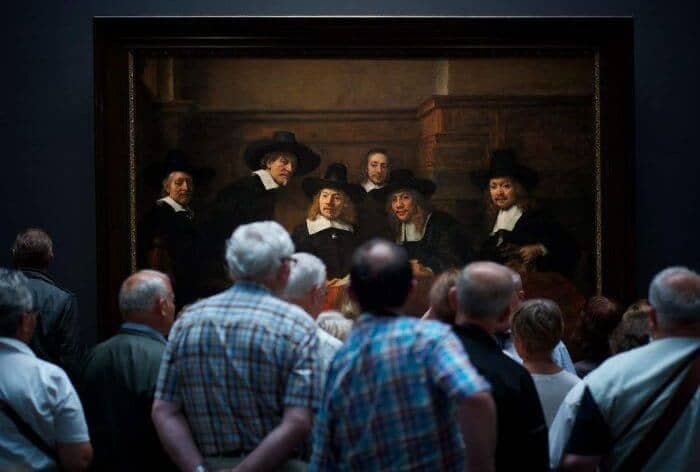Syndics of the Draper's Guild by Rembrandt

Syndics of the Draper's Guild, Rembrandt's largest portrait commission during his late years, is an ideal solution of the principal problem of painting a portrait group. Equal importance has been given to each of the
five officials - their servant, wearing a skull cap, is in the centre yet the whole is united by ingenious psychological and formal means. The subtle composition, the glowing colouristic harmonies, and above all the sympathetic
interpretation and profound psychological grasp of the personalities of the six men make this Rembrandt's greatest group portrait. The total impression is of delicately adjusted harmony and tranquillity.
Rembrandt brilliantly exploits horizontals - a classical rather than a Baroque device - for the unification of the group. Three horizontals run through the picture at almost equal intervals: the edge of the table and the arm
of the chair at the left mark the lowest one; the middle one is established by the prevailing level of the heads; and the upper one runs along the edge of the wainscoting. But here again Rembrandt avoids all formal rigidity.
These repeated horizontals are broken by sharp deviations on all three levels. The sharpest is in the group itself, in the strong curve of the head on the left. With a kind of contrapuntal effect, this movement is echoed by
the slight rise in the upper horizontal on that side.

While this style of composition is similar to the relief-like manner of grouping favoured by artists who worked in the classical tradition, there is an increased effect of space and atmosphere by Rembrandt's use of chiaroscuro
and colour. The harmonies are definitely on the warm side. A flaming red in the rug on the table, which is the most outstanding accent, is interwoven with golden tints. Golden browns reappear in the background, in the panels
of the wall, and within these warmly coloured surroundings the strong blacks and whites in the men's costumes have a noble and harmonious effect.
The traditional interpretation of the painting is that the men were shown seated on a platform, before the assembly of the Drapers' Guild and that they are giving to the assembly - unseen by the viewer - an account of the
year's business. The official seated near the centre of the picture makes a gesture with his right hand which most seventeenth-century observers understood immediately; the gesture was a standard one employed by orators
demonstrating evidence.




















